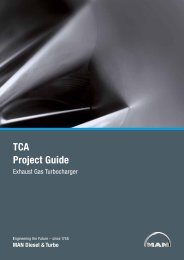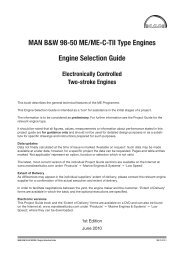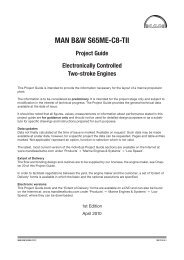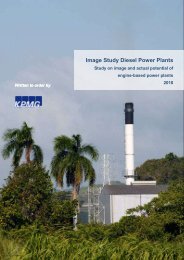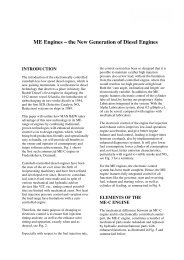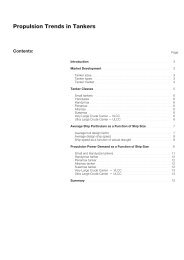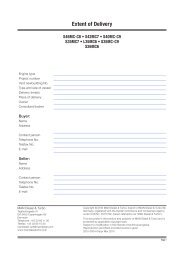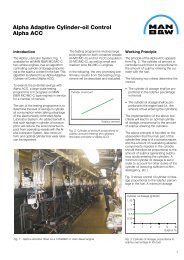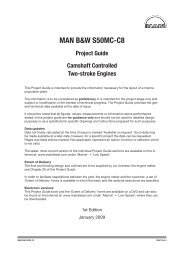Create successful ePaper yourself
Turn your PDF publications into a flip-book with our unique Google optimized e-Paper software.
<strong>Common</strong> <strong>Rail</strong><br />
Design and maturity
Introduction<br />
<strong>MAN</strong> <strong>Diesel</strong> & <strong>Turbo</strong> is the world’s leading designer and manufacturer of low and medium<br />
speed engines – engines from <strong>MAN</strong> <strong>Diesel</strong> & <strong>Turbo</strong> cover an estimated 50% of the power<br />
needed for all world trade. We develop two-stroke and four-stroke engines, auxiliary<br />
engines, turbochargers and propulsion packages that are manufactured both within the<br />
<strong>MAN</strong> <strong>Diesel</strong> & <strong>Turbo</strong> Group and at our licensees.<br />
The coming decades will see a sharp<br />
increase in the ecological and economic<br />
demands placed on internal<br />
combustion engines. Evidence of this<br />
trend is the yearly tightening of emission<br />
standards worldwide, a development<br />
that aims not only at improving<br />
fuel economy but above all at achieving<br />
clean combustion that is low in emissions.<br />
Large reductions in NOX , CO2 and soot<br />
emissions are a strategic success factor<br />
for HFO diesel engines. Special em-<br />
NO X (g / kWh)<br />
18<br />
16<br />
14<br />
12<br />
10<br />
8<br />
6<br />
4<br />
2<br />
Fig. 1: IMO NO X-legislation<br />
IMO Tier I – now<br />
phasis is placed on low load operation,<br />
where conventional injection leaves little<br />
room for optimization, as the injection<br />
process, controlled by the camshaft,<br />
is linked to engine speed. Thus, possibilities<br />
for designing a load-independent<br />
approach to the combustion process<br />
are severely limited.<br />
<strong>MAN</strong> <strong>Diesel</strong> & <strong>Turbo</strong>’s common rail<br />
technology (CR) severs this link in<br />
medium speed four-stroke engines. CR<br />
permits continuous and load-independent<br />
control of injection timing, injection<br />
-20%<br />
IMO Tier II (global) – 2011<br />
- 80% IMO Tier III (SECA’S) – 2016<br />
200 400 600 800 1000 1200 1400 1600 1800 2000 2200<br />
Rated engine speed (rpm)<br />
pressure and injection volume. This<br />
means that common rail technology<br />
achieves the highest levels of flexibility<br />
for all load ranges and yields significantly<br />
better results than any conventional<br />
injection system.<br />
A reliable and efficient CR system for an<br />
extensive range of marine fuels has<br />
been developed, and is also able to<br />
handle residual fuels (HFO).<br />
<strong>Common</strong> <strong>Rail</strong> – Design and maturity<br />
3
System Description<br />
The <strong>MAN</strong> <strong>Diesel</strong> & <strong>Turbo</strong> CR system was<br />
designed for operation with HFO in<br />
accordance with specification DIN ISO<br />
8217 (viscosities up to 700 cSt at 50°C)<br />
and fuel temperatures of up to 150°C (to<br />
achieve the required injection viscosity).<br />
In addition to high viscosity, this fuel also<br />
typically has a high content of abrasive<br />
particles and very aggressive chemical<br />
components.<br />
The injection system must be able to<br />
withstand these conditions in a failsafe<br />
way, including starting and stopping the<br />
engine during HFO operation.<br />
Using just one pressure accumulator<br />
(common rail) for large bore diesel engines,<br />
extended over the entire engine<br />
length, is problematic for the following<br />
reasons:<br />
� The different fuels that the engine<br />
can run on is reflected in the required<br />
fuel temperature (25°C to 150°C),<br />
and this in turn causes significant<br />
differences in the linear thermal expansion<br />
of the rail.<br />
� A long rail requires radial drillings for<br />
the connection to each cylinder unit.<br />
Very high material stresses caused<br />
by these drillings are unavoidable.<br />
The problems and the scope of<br />
countermeasures therefore increase<br />
pro portionally to the increased inner<br />
diameter of the rail in larger engines.<br />
� In the case of reduced accumulator<br />
volumes, it would hardly be possible<br />
to achieve identical injection ratios for<br />
all engine cylinders, and excessive<br />
pressure fluctuations in the system<br />
could not be ruled out.<br />
4 <strong>Common</strong> <strong>Rail</strong> – Design and maturity<br />
CR unit<br />
Fig. 2: CR injection system<br />
High pressure pump<br />
� Different numbers of cylinders would<br />
lead to various common rails, too.<br />
� Supplying a pressure accumulator of<br />
excessive length by connecting it to<br />
the high-pressure pump at one point<br />
only will result in deviations in injection<br />
quality.<br />
It is therefore reasonable to divide<br />
the accumulator into several units of<br />
suitable volume and to divide the supply<br />
into at least two high-pressure pumps<br />
for a six-cylinder engine. A further advantage<br />
of this segmentation is the<br />
increased flexibility to adapt the CR<br />
system to different numbers of cylinders,<br />
which is also an interesting factor when<br />
considering retrofit applications. The<br />
more compact design of the CR units<br />
ensures improved utilization of available<br />
space in the engine, which is beneficial<br />
for assembly. It also has advantages<br />
regarding the storage of spare parts.<br />
Camshaft<br />
Based on the concept of segmented<br />
rails, <strong>MAN</strong> <strong>Diesel</strong> & <strong>Turbo</strong> has developed<br />
a modular CR system which is<br />
applied to several engine types. For<br />
instance, a seven-cylinder engine is<br />
supplied by four rail units, whereby<br />
three rails each supply two cylinder<br />
units and one rail unit supplies one<br />
cylinder unit.<br />
Injector
Layout and Functionality<br />
Fig. 3 shows the hydraulic layout of the<br />
patented heavy fuel oil CR injection<br />
system for the <strong>MAN</strong> 32/44CR engine.<br />
From the fuel system, delivered fuel is<br />
led through electromagnetic activated<br />
throttle valves 1 and suction valves 2<br />
to the high-pressure pumps 3 , which<br />
supply the rail units 5 with fuel under<br />
high pressure up to 1,600 bar by means<br />
of pressure valves 4 .<br />
The rail units 5 , which function as a<br />
pressure and volume accumulator for<br />
fuel, consist of a high-strength tube<br />
closed with end covers in which a<br />
control-valve carrier 6 is integrated.<br />
The control valves 7 are fixed on to the<br />
control-valve carrier. Connections for<br />
high-pressure pipes are radially arranged<br />
on the control-valve carrier; these connections<br />
lead to the injectors 8 , as well<br />
as to the next rail unit. This design means<br />
the tube itself requires no drilling and<br />
is therefore highly pressure-resistant.<br />
To guarantee uniform fuel injection,<br />
pressure fluctuations in the system<br />
must remain at a very low level. This is<br />
achieved by using rail units of optimum<br />
volume, several (two to four) high-pressure<br />
pumps instead of one single pump,<br />
and a camshaft with a carefully arranged<br />
triple cam lobe for optimum drive.<br />
The high and uniform delivery volume<br />
obtained in this way plays a key role in<br />
keeping pressure fluctuations very low.<br />
As much fuel as necessary is supplied<br />
to the high-pressure pumps, in order to<br />
keep the rail pressure at the setpoint.<br />
The rail pressure will be calculated by a<br />
characteristic map in the injection control,<br />
according to the engine load. The<br />
electromagnetically activated throttle<br />
valve 1 in the low-pressure area will<br />
then suitably meter the fuel quantity<br />
supplied to the high-pressure pumps.<br />
11<br />
Fig. 3: CR injection system – general layout and functionality<br />
Each rail unit (Fig. 4) contains components<br />
for fuel supply and injection timing<br />
control.<br />
The fuel flow leads from the interior of<br />
the rail unit through a flow limiter to the<br />
3 / 2-way valve and then to the injector.<br />
The flow limiter consists of a springloaded<br />
piston which carries out one<br />
stroke for each injection, thereby the<br />
Fig. 4: Control valve and integrated components<br />
10<br />
9<br />
2 / 2-way valve / solenoid<br />
Flow limiter<br />
3 / 2-way valve<br />
Break<br />
leakages<br />
14<br />
Fuel<br />
outlet / inlet<br />
Break<br />
leakages<br />
3<br />
13<br />
5<br />
1<br />
4<br />
Camshaft<br />
Control quantitiy<br />
Next rail<br />
unit<br />
Non return valve<br />
Control cut off quantity<br />
8<br />
6<br />
12<br />
7<br />
2<br />
piston stroke is proportional to the<br />
injected fuel quantity. Afterwards the<br />
piston returns to its original position.<br />
Should the injection quantity exceed<br />
however a specified limit value, the<br />
piston will be pressed to a sealing seat<br />
at the outlet side at the end of the<br />
stroke and will thus avoid permanent<br />
injection at the injector.<br />
Injection<br />
valve<br />
Formation of injection pressure Injection timing<br />
<strong>Rail</strong><br />
unit<br />
<strong>Common</strong> <strong>Rail</strong> – Design and maturity<br />
5
The 3 / 2-way valve (Fig. 4) inside the<br />
control valve is operated and controlled<br />
without any additional servo fluid by an<br />
electromagnetically activated 2 / 2-way<br />
valve. It can therefore be actuated much<br />
more quickly than a servo-controlled<br />
valve. It enables the high-pressure fuel<br />
to be supplied from the rail unit, via the<br />
flow limiter, to the injector.<br />
1. Valve positions between two injections<br />
Drain throttle<br />
Controlling crosssection<br />
3/2-way valve<br />
<strong>Rail</strong> unit<br />
Feed<br />
throttle<br />
Controlling off cross-section<br />
Injector<br />
3. Start of the opening of the 3 / 2-way valve<br />
3/2-way valve<br />
Drain throttle<br />
Controlling crosssection<br />
<strong>Rail</strong> unit<br />
Feed<br />
throttle<br />
Controlling off cross-section<br />
Injector<br />
Fig. 5: Positions of control valve during injection<br />
Capacitive sensor<br />
Fig. 6: Leakage detection system –<br />
capacitive sensors<br />
6 <strong>Common</strong> <strong>Rail</strong> – Design and maturity<br />
Fig. 5 describes the functional principle<br />
of the control valve in the pressure-controlled<br />
CR system. Functional leakages<br />
arising during the control process of the<br />
3 / 2-way valve will be discharged back<br />
into the low-pressure system via the<br />
non-return valve (see Fig. 3 and Fig. 4).<br />
The non-return valve 13 (Fig. 3) also<br />
prevents backflow from the low-pressure<br />
2. Start of the opening of the 2 / 2-way valve<br />
Drain throttle<br />
Controlling crosssection<br />
Drain throttle<br />
Controlling crosssection<br />
3/2-way valve<br />
<strong>Rail</strong> unit<br />
3/2-way valve<br />
<strong>Rail</strong> unit<br />
Feed<br />
throttle<br />
Feed<br />
throttle<br />
Controlling off cross-section<br />
Injector<br />
4. Opening of the injection valve<br />
Controlling off cross-section<br />
Injector<br />
Valve movement Spring force Hydraulic force Hydraulic flow<br />
Detection screws<br />
Fig. 7: Leakage detection system –<br />
detection screws<br />
system into the cylinder, e.g. in case of<br />
nozzle needle seizure. A pressure-limiting<br />
valve 9 arranged on the valve block 10<br />
protects the high-pressure system<br />
against overload (Fig. 3).<br />
The fuel supply system is provided with<br />
an HFO preheating system that allows<br />
the engine to be started and stopped<br />
during HFO operation.<br />
To start the cold engine running with<br />
HFO, the high-pressure part of the CR<br />
system is flushed by circulating preheated<br />
HFO from the low-pressure fuel<br />
system. For this purpose, the flushing<br />
valve 11, located on the valve block 10<br />
at the end of the rail units will be opened<br />
pneumatically. Any residual high pressure<br />
in the system is thereby reduced<br />
and the fuel passes via high-pressure<br />
pumps 3 through the rail units 5 ; it<br />
also passes via the flushing non-return<br />
valve 12 (a bypass to ensure a higher<br />
flow rate), through the rail units 5 and<br />
back to the day tank. The necessary<br />
differential pressure for flushing the<br />
system is adjusted with the throttle<br />
valve 14.<br />
In the event of an emergency stop,<br />
maintenance, or a regular engine stop,<br />
the flushing valve 11 provides pressure<br />
relief for the whole high-pressure rail<br />
system.<br />
The high-pressure components (accumulators<br />
and high-pressure pipes) are<br />
double-walled; the resulting hollow<br />
spaces are connected and form, together<br />
with the capacitive sensors<br />
(Fig. 6) and detection screws (Fig. 7),<br />
an effective leakage detection system,<br />
enabling the rapid and specific detection<br />
of any leaks that may occur.
Advantages<br />
Fig. 8: <strong>Common</strong> rail system V32/44CR<br />
The principal advantage of CR injection<br />
is the flexibility gained by separating<br />
pressure generation and injection control.<br />
<strong>MAN</strong> <strong>Diesel</strong> & <strong>Turbo</strong> has kept its CR<br />
technology as simple as possible. For<br />
example, there is no separate servo circuit<br />
to activate the injection valves.<br />
Conventional pressure controlled injectors<br />
are used and solenoid valves are<br />
integrated into the rail units away from<br />
the heat of the cylinder heads, resulting<br />
in greater system reliability and easy<br />
maintenance.<br />
Different <strong>MAN</strong> <strong>Diesel</strong> & <strong>Turbo</strong> engine<br />
types use a very similar CR system<br />
design: for instance, the same basic<br />
design of 2 / 2- and 3 / 2-way valves is<br />
used for the control-valve unit.<br />
The use of the separate 3 / 2-way valves<br />
ensures that the injectors are only pressurized<br />
during injection. This avoids uncontrolled<br />
injection, even if a control<br />
valve or injection valve is leaking.<br />
The CR system is released for ships<br />
with single propulsion systems.<br />
Modular division of the rail units and<br />
their assignment to individual cylinder<br />
units reduces material costs and assembly<br />
effort and allows for short lengths<br />
of high-pressure injection pipes.<br />
The <strong>MAN</strong> <strong>Diesel</strong> & <strong>Turbo</strong> specific CR<br />
system design avoids pressure waves<br />
in the high-pressure pipes between the<br />
rail unit and the injector – a problem<br />
that occurs in some other CR systems,<br />
especially at the end of injection.<br />
Engines equipped with this CR technology,<br />
and thus an optimized combustion<br />
process, are also sure to meet more<br />
stringent emission regulations (IMO,<br />
World Bank) that may be imposed in<br />
future. The design ensures that smoke<br />
emissions from the funnel stay below<br />
the visibility limit.<br />
<strong>Common</strong> <strong>Rail</strong> – Design and maturity<br />
7
Safety Concept<br />
Safety in design and operation is one of the most important considerations, especially for<br />
marine engines. To ensure that all possible failures are covered by the CR safety concept,<br />
<strong>MAN</strong> <strong>Diesel</strong> & <strong>Turbo</strong> has completed an extensive failure mode and effects analysis (FMEA)<br />
process.<br />
On the basis of the FMEA, measures for<br />
failure detection and error prevention<br />
have been developed and system-integrated,<br />
but only after the successful<br />
completion of extensive validation tests<br />
on the test rig, which are vital for any<br />
new technology concept. The CR system<br />
and its safety concept, as illustrated<br />
below, are kept as simple as possible:<br />
� Injectors are only pressurized<br />
during injection<br />
No danger of uncontrolled injection,<br />
even if a control valve or injection<br />
valve leaks.<br />
� High-pressure components are<br />
double-walled<br />
No danger of fuel escaping in case<br />
of leaking or broken pipes.<br />
� Flow-limiting valves (Fig. 4) for each<br />
cylinder<br />
No danger of excessive injection<br />
quantity, even in case of leaking or<br />
broken components.<br />
� Non-return valves (Fig. 3, 13 ) for<br />
each cylinder<br />
Prevents backflow from the lowpressure<br />
system into the cylinder,<br />
e.g. in case of nozzle seizure.<br />
8 <strong>Common</strong> <strong>Rail</strong> – Design and maturity<br />
� Two to four high-pressure pumps<br />
Should one pump fail, emergency<br />
operation is possible.<br />
� Pressure-limiting valve (Fig. 3, 9 )<br />
with additional pressure-control<br />
function / safety valve<br />
Emergency operation possible, even<br />
in case of any failure in rail pressure<br />
control.<br />
� Emergency stop valve / flushing<br />
valve (Fig. 3, 11 )<br />
The valve, actuated by compressed<br />
air, stops the engine in case of<br />
emergency.<br />
� Redundant rail-pressure sensors<br />
and TDC speed pick-ups<br />
No interruption of engine operation<br />
necessary due to pick-up or sensor<br />
error.
Electronics<br />
The challenge regarding electronics was to design a simple, redundant, electronic CR system<br />
for single-engine main-propulsion applications.<br />
For single-engine main-propulsion systems,<br />
classification organizations require<br />
a full redundant system layout.<br />
The injection electronics is therefore<br />
structured as described below.<br />
The CR control is fully integrated within<br />
the SaCoSone (safety and control system<br />
on engine). Two injection modules are<br />
available (Fig. 9) to control the solenoid<br />
valves (injection time and injection<br />
duration) and the high-pressure pumps<br />
(rail pressure generation). Speed governing<br />
is performed by means of injection<br />
duration. After each engine stop,<br />
the control function changes between<br />
the two connected injection modules<br />
while maintaining full functionality. In<br />
case of malfunction of the active injection<br />
module, the back-up injection<br />
module takes over within milliseconds.<br />
All necessary sensors, the power supply<br />
and the field bus system are redundant<br />
in design. So a single failure will not<br />
lead to an engine shutdown. Via the<br />
redundant CAN bus, all necessary<br />
information is exchanged between the<br />
SaCoSone devices and are displayed on<br />
the human machine interface (HMI).<br />
Redundant arrangement for single main propulsion plants<br />
Injection module 1 Injection module 2<br />
Engine speed and<br />
crank position<br />
Fig. 9: Redundancy of electronic control system<br />
Redundant CAN bus Redundant CAN bus<br />
<strong>Rail</strong> press<br />
sensors<br />
3 / 2-way valves<br />
for injection<br />
Fuel metering valve on high<br />
pressure pump<br />
Communication to further<br />
SaCoS one units<br />
Cylinder head<br />
For multiple engine installations, a nonredundant<br />
design for CR control is<br />
available.<br />
The CR electronics extend the possibilities<br />
of the conventional injection<br />
system by means of freely adjustable<br />
injection parameters. A multitude of<br />
characteristic maps and parameters in<br />
the injection control allows optimized<br />
engine operation over the entire load<br />
range.<br />
Redundant<br />
power supply<br />
UPS<br />
<strong>Common</strong> <strong>Rail</strong> – Design and maturity<br />
9
Development Process<br />
Fig. 10: Development process<br />
The development process ensures the<br />
trouble-free market launch of a new<br />
product, as it means that a well-proven<br />
product with low technical risk will be<br />
available from start of series production.<br />
Fig. 10 gives a rough impression of the<br />
development which the new product<br />
goes through. Some important stages<br />
of the development of the CR system<br />
are described below.<br />
Simulation<br />
The <strong>MAN</strong> <strong>Diesel</strong> & <strong>Turbo</strong> common rail<br />
injection system was simulated to<br />
optimize the system before the first<br />
components were produced. This<br />
simulation tool was also particularly<br />
effective for comparing simulated results<br />
with real results.<br />
Fig. 11 shows a physical and mathemati<br />
cal model for the simulation of a<br />
one-cylinder unit including the compon<br />
ents between the unit segment and<br />
the injection nozzle.<br />
10 <strong>Common</strong> <strong>Rail</strong> – Design and maturity<br />
Concept, Design, FEMA<br />
FEM & hydraulic analysis<br />
CR test rig (> 1000 rhrs)<br />
Engine test bed (> 1000 rhrs)<br />
Type approval (classifi cation)<br />
Field test (> ~ 12000 rhrs)<br />
Serial release<br />
2 / 2-way valve<br />
Accumulator unit<br />
Design loop<br />
Fig. 11: Simulation model for one-cylinder unit<br />
3 / 2-way valve<br />
Injector<br />
Cut-off non-return valve
Hydraulic optimization and endurance<br />
testing on injection test rigs<br />
As mentioned above, heavy-fuel operation<br />
is a major challenge for all electronically<br />
controlled injection systems.<br />
<strong>MAN</strong> <strong>Diesel</strong> & <strong>Turbo</strong> therefore decided<br />
to install new test rigs especially for the<br />
hydraulic optimization and endurance<br />
testing of CR injection systems under<br />
conditions that are as realistic as possible.<br />
These test rigs are characterized<br />
by the following main features:<br />
� Installation of complete CR systems<br />
for up to 10 cylinders is pos s ible;<br />
� Fully computerized operation and<br />
measurement with the possibility<br />
of unmanned endurance runs;<br />
� Operation with different test fuels,<br />
especially with real HFO up to fuel<br />
temperatures of 150°C for endurance<br />
and hydraulic tests.<br />
Fig. 12 illustrates the comparison between<br />
the simulation and the test results<br />
to demonstrate the solid correlation between<br />
simulation and measurement.<br />
But the simulation was not limited to<br />
single cylinder units. To investigate the<br />
influence of different cylinder numbers,<br />
simulation models of the complete CR<br />
system for up to 10 cylinders were<br />
prepared and also verified by measurements.<br />
<strong>Rail</strong> pressure (bar)<br />
Needle lift (mm)<br />
1400<br />
1200<br />
1000<br />
800<br />
600<br />
400<br />
200<br />
0<br />
1.5<br />
1.0<br />
0.5<br />
0.0<br />
0.000 0.005 0.010 0.015 0.020<br />
Simulation Measurement<br />
Fig. 12: Comparison of simulation and measurement<br />
Time (sec)<br />
<strong>Common</strong> <strong>Rail</strong> – Design and maturity<br />
11
Development Process<br />
Fig. 13 shows one of these test rigs<br />
with the 32/40 CR injection system<br />
installed. In addition to the test rigs for<br />
the hydraulic and endurance tests,<br />
<strong>MAN</strong> <strong>Diesel</strong> & <strong>Turbo</strong> installed an additional<br />
test rig to check the calibration of<br />
the control valves. The results from the<br />
test engine showed how important it is<br />
for these components to be well calibrated.<br />
The optimization of the CR<br />
injection system on the injection test<br />
rigs shall be demonstrated with the example<br />
below.<br />
Fig. 14 shows the measured pressure<br />
ahead of the injection valve for three<br />
different versions of the control valve,<br />
compared to the injection pressure<br />
curve of the conventional injection<br />
system. It is easy to see that the<br />
rate of injection at the beginning of injection,<br />
which is most important for<br />
NOX- and smoke-formation with the<br />
<strong>MAN</strong> <strong>Diesel</strong> & <strong>Turbo</strong> CR system, can<br />
be optimized within a broad range in<br />
order to match the injection system to<br />
the engine’s requirements.<br />
12 <strong>Common</strong> <strong>Rail</strong> – Design and maturity<br />
Fuel-pumps <strong>Rail</strong> segments Pump rail<br />
Fig. 13: Test rig installation of the complete CR system<br />
<strong>Rail</strong> pressure (bar x 10³)<br />
1.4<br />
1.2<br />
1.0<br />
0.8<br />
0.6<br />
0.4<br />
0.2<br />
0.0<br />
0<br />
Fig. 14: Matching of the rate of injection<br />
Needle lift<br />
<strong>Rail</strong> pressure<br />
Time (sec)<br />
Version A Version B Version C Convent. inject. system<br />
2.0<br />
1.5<br />
1.0<br />
0.5<br />
0.0<br />
Needle lift (mm)
Test Results<br />
CR system – adaptation to a new<br />
engine<br />
On the engine test bed, injection pressure<br />
and injection start variations are<br />
effected at all load points within the<br />
characteristic field of the engine.<br />
Results are evaluated by taking into<br />
account the trade-off between SFOC,<br />
NOX and soot emissions. In addition,<br />
the injection quantity curve and the<br />
injection nozzle configuration are modified<br />
according to the desired effect.<br />
Due to the newly acquired flexibility of<br />
the injection parameters, which could<br />
be varied, NOX emissions, fuel consumption<br />
and exhaust-gas opacity can<br />
be improved significantly. Exhaust-gas<br />
opacity can be reduced below the<br />
visibility limit within the critical low load<br />
range.<br />
It is not surprising that only negligible<br />
advantages can be achieved at nominal<br />
load, since this operating point has<br />
been optimized in recent years in<br />
conventional injection systems.<br />
In Fig. 15, the examples show that the<br />
CR system improves the SFOC / NOX /<br />
soot trade-off in comparison to a conventional<br />
injection system.<br />
Comparison of engine performance for different injection systems<br />
Soot Emissions<br />
FSN<br />
0.7<br />
0.6<br />
0.5<br />
0.4<br />
0.3<br />
0.2<br />
0.1<br />
NO X<br />
%<br />
104<br />
100<br />
96<br />
92<br />
88<br />
SFOC<br />
%<br />
100.5<br />
100.0<br />
99.5<br />
99.0<br />
98.5<br />
98.0<br />
Conventional injection CR injection<br />
0 25 50 75 100<br />
Engine Load (%)<br />
0 25 50 75 100<br />
Engine Load (%)<br />
0 25 50 75 100<br />
Engine Load (%)<br />
Fig. 15: Comparison CR injection system – conventional injection system<br />
<strong>Common</strong> <strong>Rail</strong> – Design and maturity<br />
13
Conclusion<br />
The advantage of the CR injection<br />
system, through its freely adjustable<br />
injection parameters, has hopefully<br />
been clearly demonstrated. The design<br />
of the CR system with its comprehensive<br />
functionality, control electronics<br />
and safety devices required careful<br />
long-term technological planning, which<br />
equipped the product with the potential<br />
to meet future environmental and economic<br />
demands.<br />
14 <strong>Common</strong> <strong>Rail</strong> – Design and maturity<br />
Thanks to the results of the test<br />
programmes and the corresponding<br />
component development, a remarkable<br />
level of maturity has been achieved and<br />
confirmed by field tests of different<br />
applications lasting approximately<br />
200,000 operating hours in total.<br />
References Engine type Power output Application Commissioning<br />
A.P. Moeller, M/S Cornelia<br />
Maersk, Sweden<br />
A.P. Moeller, M/S Clementine<br />
Maersk, Denmark<br />
Essberger GmbH, DAL<br />
Kalahari, Germany<br />
A.P. Moeller, M/S Charlotte<br />
Maersk, Denmark<br />
A.P. Moeller, M/S Columbine<br />
Maersk, Denmark<br />
A.P. Moeller, M/S Olga<br />
Maersk, Denmark<br />
NCL, Norwegian Jewel,<br />
USA<br />
DFDS, Tor Petunia,<br />
Denmark<br />
Scandlines, Prinsesse<br />
Benedikte, Denmark<br />
5x7L32/40<br />
thereof 1x7L32/40CR<br />
15,750 kW Container Vessel 02.2004<br />
5x7L32/40<br />
thereof 1x7L32/40CR<br />
15,750 kW Container Vessel 12.2004<br />
4x6L32/40<br />
thereof 1x6L32/40CR<br />
8,640 kW Container Vessel 09.2005<br />
5x7L32/40<br />
thereof 1x7L32/40CR<br />
15,750 kW Container Vessel 03.2006<br />
5x7L32/40<br />
thereof 1x6L32/40CR<br />
15,750 kW Container Vessel 06.2006<br />
4x6L32/40<br />
thereof 1x6L32/40CR<br />
11,520 kW Container Vessel 11.2006<br />
5x12V48/60B<br />
thereof 1x12V48/60CR<br />
14,400 kW Cruise Liner 05.2007<br />
4x8L21/31<br />
hereof 1x8L21/31CR<br />
12,800 kW Ro-Ro / Ferry 05.2008<br />
1x6L32/44CR 3,360 kW Passenger Ferry 04.2007
<strong>MAN</strong> <strong>Diesel</strong> & <strong>Turbo</strong><br />
86224 Augsburg, Germany<br />
Phone +49 821 322-0<br />
Fax +49 821 322-3382<br />
marineengines@mandieselturbo.com<br />
www.mandieselturbo.com<br />
Copyright © <strong>MAN</strong> <strong>Diesel</strong> & <strong>Turbo</strong> · Subject to modification in the interest of technical progress. · D2366466EN Printed in Germany KM-08101



